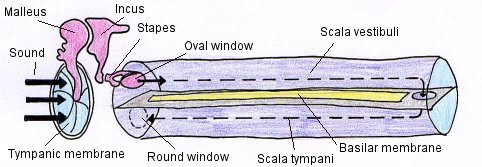Hearing Process
The sound waves, which pass the incus
and are then caught by the oval window, produce
continuous shockwaves in the perilmph of the vestibule canal. They are passed
on to the top of the cochlea and return trough the scala tympani until they reach
the round window which is responsible for the pressure balance. The contra-rotating
fluid of the perilymph in the scala vestibuli and in the scala tympani causes
vibrations of the endolymph in the cochlea canal, thus moving Corti´s organ
towardsthe tectorial membrane and as a consequence sensory hairs of the hair cells
are bent. In these hair cells the mechanic energy of the sound waves are changed
into electro-chemical energy and are passed on to the brain as nerve impulses
via the auditory nerve.
The human hearing range is between 16
Hz - 20 kHz.
Sounds of different frequencies cause
vibrations in different areas of the basilar membrane. High
pitched sounds are registed nearthe oval window (at the narrow part of the
basilar membrane) low sounds at the top of the cochlea (at the wide part of
the basilar membrane).


